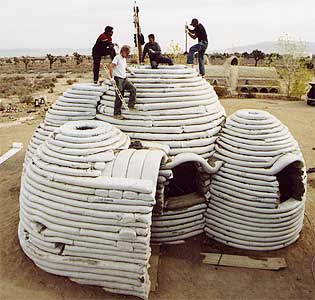Sandbag Houses
Can anybody really build a house made of sandbags?
Sandbags conjure up images of winter flooding or cheap mobile
barriers used at roadsides, construction sites and the natural
extension of this thought process may not be to use of sandbags
to build structures, even homes. To the contrary, these simple
materials create solid and virtually impregnable walls, which
are incredibly resistant to bad weather conditions including wind
and rain.

Sandbag House Being Built |
|
Some of the main advantages of building sandbag houses is the
components are cheap, easily available and easily transferable.
The use of sandbags in house building reduces CO2 emissions by
up to 95-percent compared to standard brick built walls and there
is no processing of materials prior to use in the construction.
In addition, sandbags can be up to 40-percent cheaper than brick.
Couple this with the fact that when sandbag houses are completed
with plastered exterior and interior walls, they will look identical
to a house built from conventional materials.
Gunny Sack Races ...
As different and more diverse methods of house building began
to develop, the use of sandbags developed also. This development
is the result of learning from tried and tested procedures. Until
recently Burlap Sacks were filled with sand or earth and placed
around wooden beams.
Then they were layered with plaster in order to create the exterior
walls. This helped to reinforce the structure against any unfavourable
conditions and create thermally efficient homes. The main disadvantage
with the natural material, i.e. the burlap sacks, was that as
it aged, and with any penetration of water, the sack would eventually
rot.
|
Currently there are polypropylene bags
available and they are now widely used. A plaster is placed
over them and it can provide a reliable and permanent structure
for the purpose of housing. This process still takes into
account the vapor permeable walls associated with sandbag
construction.
|
|
The thermal efficiency of the building will also depend on the
type of material used to fill the bags and this can range from
sand to soil to crushed volcanic rock. Another added benefit of
this housing is the naturally occurring soundproofing that is
attained through the use of sand in the bags.
The ease with which these buildings can be constructed is reflected
in the amount of materials readily available, coupled with advice
tips and instructions for the building of a sandbag house. This
type of structure is not even restricted to specific areas of
construction. Just one person can easily handle the weight of
each sand bag and construction can take place without the need
for proper road access or electricity.
 |
The versatile value of this type of
construction has proved invaluable in Cape Town in South
Africa. A number of building projects in areas with little
or no financial resources were successfully completed with
the use of sandbags.
|
Conclusion
This proves the fact that apart from being ecologically friendly,
sandbag houses are also cost-effective and offer a very good alternative
to the conventional building methods.
|

